
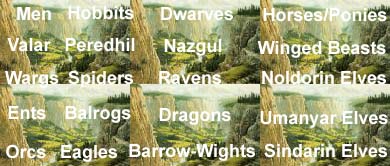
The Secondborn of the Children of Illuvitar, Men awakened with the
rising of the Sun at the beginning of the First Age of the Sun. Men
were given the gift of Mortality, to die and leave the circles of the
World. By the time that Men first entered the records of the Elves in
Beleriand (see The Silmarillion) the Men who entered Beleriand were
already split into three houses:
At the end of the First Age when Beleriand was destroyed, some of the Edain fled East, while others were gifted with the land of Numenor (Westernesse). Those that fled East became the Northmen of Rhovanion, of whom were descended the Rohirrim. Those that went West, became known as the Dunedain, who had life three times that of lesser Men.
After the Fall of Numenor, the Dunedain (those that survived) founded the realms of Gondor and Arnor. Arnor was eventually destroyed by the Witchking of Angmar, though the line of Kings remained unbroken as chieftains. In Gondor, the line of the Kings failed and the Stewards ruled. At the End of the Third Age the two realms were reunited under the kingship of Aragorn who took the name Elessar.
Hobbits have the unusual characteristic of having tough soles on their
feet, as well as hair that covers all the way to their toes, so their
feet stay warm. Hobbits do not tend to wear boots or shoes in any form,
though where the land is low and muddy, they will wear boots to keep
their feet dry (especially the Stoors).
Hobbits also tended to live in burrows, often with many generations
of one family in a very large one (eg. Brandy Hall or the Great Smials
of Tuckbourogh). As suitable areas of these burrows often did not exist,
Hobbits started to build houses, though they were still long and low.
Even where they could burrow, hobbits tended to build workshops and
sheds and the like.
It is unknown where Hobbits came from, though after 1050 of the Third
Age of the Sun, they started to wander Westwards over the Misty Mountains.
This was after the Shadow fell on Greenwood the Great near where they
lived (eg. Smeagol/Gollum and Deagol). Hobbits were split into three
"kinds":
The Dwarves were created by Aule, because he was impatient for someone
to teach. However, Illuvitar gave them life though they were to sleep
in distant places until after the Elves, or Firstborn childeren of Illuvitar
were awakened. Dwarves are short (though not as short as the Hobbits)
ranging between four and five feet high, strong and they have beards
(both males and females). Among the more famous of the Dwarven mansions
include:
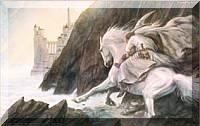 Horses
and ponies have always been used by Men and Elves. Those breeds that
are descended from Nahar (the horse of Orome) are usually white or silver-grey,
fleet, long-lived and can often understand the speech of Men and Elves.
One example of this type is the Mearas, the horses of the Kings of Rohan.
Snowmane was one of the Mearas, as was Shadowfax, the mount of Gandalf.
Shadowfax broke the rule that only the Lords of Rohan could ride one
of the Mearas, and Shadowfax was the finest of the Mearas.
Horses
and ponies have always been used by Men and Elves. Those breeds that
are descended from Nahar (the horse of Orome) are usually white or silver-grey,
fleet, long-lived and can often understand the speech of Men and Elves.
One example of this type is the Mearas, the horses of the Kings of Rohan.
Snowmane was one of the Mearas, as was Shadowfax, the mount of Gandalf.
Shadowfax broke the rule that only the Lords of Rohan could ride one
of the Mearas, and Shadowfax was the finest of the Mearas.
Ponies are more often used by Hobbits and Dwarves, being as they are smaller than Horses and so easier for these smaller peoples to ride. Some ponies in the Lord of the Rings included the five that Merry had ready for their escape from Buckland. They were frightened by the Nazgul and fled to Tom Bombadil from Bree after the raid. Bill, the pony bought in Bree. Bill remained with the company untill Moria, when Gandalf freed him to return to wherever he wanted to go, in this case Bree. Merry had a pony for the ride from the Hornburg to Dunharrow. All the hobbits had ponies for the ride back to the Shire at the end of the War of the Ring. In Bree, Sam found Bill and took him back with them.
 The
Valar are the powers of the world, There are two "ranks": The Valar,
and the Maiar. The Valar are the stronger. They are:
The
Valar are the powers of the world, There are two "ranks": The Valar,
and the Maiar. The Valar are the stronger. They are:
|
|
|
There were many of the Maiar, though few are named. Those named include:
The Peredhil, or the Half-Elven are those with one Elvish parent and
one parent a Man. There were only three of these unions made in Middle-Earth:
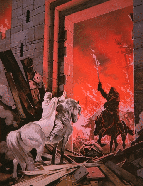
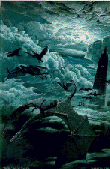 The
Nazgul were not properly a race at all. They were men who after being
given the Nine Rings by Sauron eventually faded and became permanently
invisible. They had no will of their own, but were entirely controlled
by the Dark Lord. Almost none could withstand them, especially when
they were all together. The exceptions being Saruman, Gandalf and some
of the Elves, such as Glorfindel. Almost no animals would face the Nazgul,
especially the Lord of the Nazgul, save the horses bred in the Black
Land. Shadowfax was the exception to this as to many others:
The
Nazgul were not properly a race at all. They were men who after being
given the Nine Rings by Sauron eventually faded and became permanently
invisible. They had no will of their own, but were entirely controlled
by the Dark Lord. Almost none could withstand them, especially when
they were all together. The exceptions being Saruman, Gandalf and some
of the Elves, such as Glorfindel. Almost no animals would face the Nazgul,
especially the Lord of the Nazgul, save the horses bred in the Black
Land. Shadowfax was the exception to this as to many others:
The Lord of the Rings, page 861:
In rode the Lord of the Nazgul. A great black
shape against the fires beyond, he loomed up, grown to a vast menace
of despair. In rode the Lord of the Nazgul, under the arch that no enemy
ever yet had passed, and all fled before his face.
All save one. There waiting silent and still in the space before the
Gate, sat Gandalf upon Shadofax, Shadowfax who alone among the free
horses of the earth endured the terror, unmoving, steadfast as a graven
image in Rath Dinen.
The Ringwraiths, had many names, including Fell Riders (Gondor), Nazgul
(Black Speech), Black Riders (Hobbits) and Ulari (Elvish). They were
Sauron's main servants, the captains of his armies, and the main searchers
for the Ring. For the search for the Ring, they rode black horses, that
were extremely swift. For the most part during the War, in fact from
the attack on the Company on the River Anduin, they mostly rode the
Winged Beasts.
The most powerful of the Ringwraiths was the Lord of the Nazgul, who
was the one to wound Frodo on Weathertop. He was known as the Witch-king
of Angmar to the North Kingdom of Arnor, the Morgul-Lord in Gondor as
well as many other names. The Witch-King was slain by Eowyn and Merry
during the Battle of the Pelennor fields. The other eight ringwraiths
were destroyed with the destruction of the Ring in Mount Doom. The Nazgul
were afraid of fire and were strongest in deserted places far from help
(eg. Weathertop) and at night.
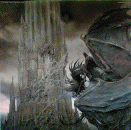 Nobody
knows quite what the Winged beasts are, but one of the best guesses
is from the Lord of the Rings, page 873:
Nobody
knows quite what the Winged beasts are, but one of the best guesses
is from the Lord of the Rings, page 873:
A creature of an older world maybe it was,
whose kind, lingering in forgotten mountains cold beneath the Moon,
outstayed their day, and in a hideous eyrie bred this last untimely
brood, apt to evil. And the Dark Lord took it and nursed it with fell
meats, until it grew beyond the measure of all other things that fly;
and he gave it to his servant to be his steed.
There were at least ten of the Winged Beasts, as one of the Nazgul had one shot out from under him by Legolas when he attacked the Company from the east bank of the Anduin River.
They were like bats in that they had no feathers, but neither did they have any fur. They were quite naked.
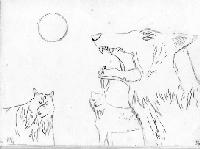 Wargs
are evil wolves that are often used by Orcs as steeds. They are also
totally independent of the Orcs and hunt on their own.Wargs tend to
be found on the eastern side of the Misty Mountains. When killed, the
bodies seem to disappear somehow.
Wargs
are evil wolves that are often used by Orcs as steeds. They are also
totally independent of the Orcs and hunt on their own.Wargs tend to
be found on the eastern side of the Misty Mountains. When killed, the
bodies seem to disappear somehow.
The Lord of the Rings, page 315:
Suddenly Aragorn leapt to his feet. "How the wind howls!"
he cried. "It is howling with wolf voices. The Wargs have come west
of the Mountains!"
The Lord of the Rings, page 316:
When the full light of morning came no signs
of the wolves were to be found, and they looked in vain for the bodies
of the dead. No trace of the fight remained but the chared trees and
the arrows of Legolas lying on the hilltop. All were undamaged save
one of which only the point was left.
"It is as I feared," said Gandalf. "These were no ordinary wolves hunting
for food in the wilderness. Let us eat quickly and go!" They are
fully intelligent and can converse with Orcs. One thing that Wargs are
afraid of is fire.
The Spiders referred to here are not the normal sized garden spiders,
but spiders of a size capable of capturing a man, or at least a Dwarf
or a Hobbit!
There have been Giant Spiders in Middle-Earth from the beginning of
Time, beginning with Ungoliant, who killed the Two Trees of Valinor,
down to the Spiders of Mirkwood and Dungortheb. These Spiders are the
descendants of Ungoliant, who eventually (we think) starved to death
in the South-East of Middle-Earth, ere the beginning of the Third Age
of the Sun. Shelob who, at the time of the War of the Ring was the greatest
of the Giant Spiders, was probably killed by the wounds Sam gave her,
lived for a very long time in the mountains of Mordor, where the pass
nigh to Minas Ithil was. Shelob survived the wounds to flee into her
lair, where we have no more information about her.
The Giant Spider's webs are extremely tough, and hard to cut. This does
not show in The Hobbit, as Bilbo was using an elvish sword which he
then called Sting. It was found by Frodo and Sam when fleeing Shelob
that the Elvish sword, Sting cut the webs with ease, while Sam's sword
out of the Barrow-downs hardly cut the threads at all. These Spiders
could apparently talk, as they were heard talking to one another by
Bilbo and recorded in his diary.
 Ravens
were the allies of the Dwarves of the Lonely Mountain, and were used
as messengers between Thorin and Dain Ironfoot before the Battle of
the Five Armies. They could speak in the Common Speech. Ravens are obviously
fairly long-lived, as the raven, Roac, was over one hundred and fifty
years old at the time of the Battle of the Five Armies in the year 2941
of the Third Age. Ravens are especially friendly to Dwarves, and have
very long memories.
Ravens
were the allies of the Dwarves of the Lonely Mountain, and were used
as messengers between Thorin and Dain Ironfoot before the Battle of
the Five Armies. They could speak in the Common Speech. Ravens are obviously
fairly long-lived, as the raven, Roac, was over one hundred and fifty
years old at the time of the Battle of the Five Armies in the year 2941
of the Third Age. Ravens are especially friendly to Dwarves, and have
very long memories.
For more information, see The Hobbit, which was Bilbo's diary.
There were three groups of Elves from the beginning that started on
the Western Road: The Noldor did enter the West, and remained there until Melkor, with the
aid of Ungoliant, killed the Two Trees, and stole Feanor's greatest treasure,
the Silmarils. The Noldor were the greatest of the craftsmen of the Elves.
It was Rumil who first created letters for recording the tales and legends,
though Feanor later improved on them with the Feanorian Alphabet. It was
Feanor who was the greatest of the craftsmen of all time. After the Silmarils
were stolen, Feanor and his sons swore to regain them and left Valinor
with the greatest part of the Noldorin Elves.
![]() The Noldor
The Noldor
![]() The Vanyar
The Vanyar
![]() The Teleri
The Teleri
They and all the Noldor who left with them came under the Ban of the Valar
and the Doom of the Noldor:
The Silmarillion, pages 103-104:
Tears unnumbered ye shall shed; and the Valar
will fence Valinor against you, and shut you out, so that not even the
echo of your lamentation shall pass over the moutains. On the House of
Feanor the wrath of the Valar lieth from the West unto the uttermost East,
and upon all that will follow them it shall be laid also. Their Oath shall
drive them, and yet betray them, and ever snatch away the very treasures
that they have sworn to pursue. To evil end shall all things turn that
they begin well; and by treason of kin unto kin and the fear of treason,
shall this come to pass. The Disposessed shall they be forever.
Ye have spilled the blood of your kindred unrighteously and have stained
the land of Aman. For blood ye shall render blood, and beyond Aman ye
shall dwell in Death's shadow. For though Eru appointed to you to die
not in Ea, and no sickness may assail you, yet slain ye may be, and slain
ye shall be: by weapon and by torment and grief; and your houseless spirits
shall come then to Mandos. There long shall ye abide and yearn for your
bodies, and find little pity though all whom ye have slain should entreat
for you. And those that endure in Middle-earth and come not to Mandos
shall grow weary of the world as with a great burden, and shall wane,
and become as shadows of regret before the younger race that cometh after.
The Valar have spoken.
Those under this ban were forbidden to return into the West. The last
of them was Galadriel, who was permitted to return after the War of
the Ring, thanks to her not accepting the One Ring when it was offered
to her.
For more information on the history of the Noldor, see the Quenta Silmarillion,
which is comprised mostly of the history of their deeds throughout the
Elder Days.
 Ents
are the guardians of the trees, requested by Yavanna. They look just
like trees, understand them and guard them from senseless destruction
by those like Saruman and his slaves. According to Treebeard, who at
the time of the end of the Third Age, was the oldest of the Ents, they
were awakened by the Elves when the world was young. They tend to do
things slowly, unless angered, and they can destroy rock with just their
feet and hands. The result looks like that of tree roots over time.
It was thus that they destroyed Isengard.
Ents
are the guardians of the trees, requested by Yavanna. They look just
like trees, understand them and guard them from senseless destruction
by those like Saruman and his slaves. According to Treebeard, who at
the time of the end of the Third Age, was the oldest of the Ents, they
were awakened by the Elves when the world was young. They tend to do
things slowly, unless angered, and they can destroy rock with just their
feet and hands. The result looks like that of tree roots over time.
It was thus that they destroyed Isengard.
The Ents aided in the Battle of the Hornburg, as well as defending the
western area of Rohan during the Battle of the Pelennor Fields for many
orcs invaded Rohan while it was thought to be undefended.
 Balrogs
were Maiar spirits of fire corrupted by Melkor in the beginning of the
World. They were black and it was hard to see what exactly their shape
was inside the shadow they carried with them. Their main weapon was
a whip of many fiery thongs. Most were destroyed in the destruction
of Beleriand though at least one survived and fled under Caradhras,
where he was accidently released by the Dwarves of Khazad-dum. It was
because of this that the mines gained the name Moria, the Black Chasm.
This Balrog was destroyed by Gandalf, though he himself died as a result.
Balrogs
were Maiar spirits of fire corrupted by Melkor in the beginning of the
World. They were black and it was hard to see what exactly their shape
was inside the shadow they carried with them. Their main weapon was
a whip of many fiery thongs. Most were destroyed in the destruction
of Beleriand though at least one survived and fled under Caradhras,
where he was accidently released by the Dwarves of Khazad-dum. It was
because of this that the mines gained the name Moria, the Black Chasm.
This Balrog was destroyed by Gandalf, though he himself died as a result.
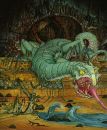
 Dragons
arose through the malice of Morgoth, in the First Age of the Sun. Of
these Glaurung was the first of the Uruloki, the fire-breathing dragons.
Glarung did not have wings and was more like a lizard than Smaug as
we see him in The Hobbit. There were three types of dragons: The Uruloki,
the Cold Drakes and the Winged Dragons.
Dragons
arose through the malice of Morgoth, in the First Age of the Sun. Of
these Glaurung was the first of the Uruloki, the fire-breathing dragons.
Glarung did not have wings and was more like a lizard than Smaug as
we see him in The Hobbit. There were three types of dragons: The Uruloki,
the Cold Drakes and the Winged Dragons.
Smaug was of the last of the three types.
The first of the Winged Dragons was Ancalagon the Black, whos name meant
Rushing Jaws. He was slain during the last defense of Angband, by Earendil
and all of the birds such as the Eagles. From the first, it seems, that
dragons have always been treasure-lovers,and love to hoard valuables,
eg. Glaurung did so after the sack of Nargothrond. Dragons mentioned
in the course of the legends from Middle-Earth included:
The Umanyar were the elves that never started into the West. They were grouped among the Morquendi, the Dark Elves. Other than that there is little to say about the Umanyar.
No-one is certain where Orcs came from, but one possibility is that Morgoth bred them from Elves that he had captured. From the first, the Elves have had legends of dark shapes and elves that had disappeared in the dark. Orcs have always been on the side of the Dark Lord, be he Morgoth or Sauron. Saruman also had armies of Orcs, which he used to attack the Rohirrim, during the War of the Ring. Orcs were intellegent, though they used the Common Speech in conversation with other tribes of their kind as their own speech was useful for little more than cursing, and was so different in each tribe that it was useless for communication.
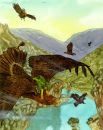
 Eagles
are often used as the eyes of Manwe as well as warning against something
(as in the case of the eagle-shaped clouds over Numenor). They are enemies
of the servants of Mordor, as well as hindering the Orcs whenever they
can. Thus was it that they rescued Bilbo, Gandalf and the Dwarves from
the Wargs and the Orcs in The Hobbit, they also were the turning force
and the fifth army in the Battle of the Five Armies.
Eagles
are often used as the eyes of Manwe as well as warning against something
(as in the case of the eagle-shaped clouds over Numenor). They are enemies
of the servants of Mordor, as well as hindering the Orcs whenever they
can. Thus was it that they rescued Bilbo, Gandalf and the Dwarves from
the Wargs and the Orcs in The Hobbit, they also were the turning force
and the fifth army in the Battle of the Five Armies.
In the First Age, the Eagles made their homes in the mountains surrounding
Gondolin, and rescued the body of Glorfindel after the Fall of Gondolin.
Their leader in the First Age was Thorondor. It was Thorondor who rescued
the body of Glorfindel, and helped with the escape of the remaining
survivors of Gondolin, aided in the rescue of Maedhros, and wounded
Morgoth after Fingolfin died in single combat against him. Not only
that, but Thorondor led the Eagles in the final battles against Morgoth
at the end of the First Age.
Gwaihir was the Lord of the Eagles at the end of the Third Age and at need would bear Gandalf away from somewhere he could not else have escaped, eg. Orthanc, or the peak of Zirak-Zigil or rescuing the dwarves (with one hobbit and wizard) from the orcs. Gwaihir was the one that carried Gandalf into Mordor to rescue Frodo and Sam from the fury of Mount Doom after the destruction of the Ring.
Barrow-wights are evil spirits that inhabit the burial mounds known
as barrows. The are possible relatives of the Ringwraiths.
It is known for certain that light destroyed the Barrow-wights, as the
example of Tom Bombadil shows in the chapter Fog on the Barrow-downs.
The Barrow-downs are the only known place that is inhabited by the Barrow-wights.
They entered at the command of the Witch-King of Angmar early in the
Third Age of the Sun.
There were three groups of Elves from the beginning that started on
the Western Road:
The books I have used in compiling this document are:


